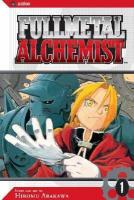
 The first volume of the series serves as an introduction to the character, world, difficulties, and companions of Edward Elric, the Fullmetal Alchemist. Orphaned at a young age, the eleven-year-old prodigy and his younger brother, Alphonse, attempt forbidden human transmutation in an effort to resurrect their mother. They learn the hard way why it's forbidden, when Al's body vanishes along with Ed's left leg, shortly followed by his right arm—the price to keep his brother's soul and bind it to a suit of armor. The series opens four or so years later, after Ed's debased himself by joining the military in exchange for access to resources in his efforts to restore his brother and himself.
The first volume of the series serves as an introduction to the character, world, difficulties, and companions of Edward Elric, the Fullmetal Alchemist. Orphaned at a young age, the eleven-year-old prodigy and his younger brother, Alphonse, attempt forbidden human transmutation in an effort to resurrect their mother. They learn the hard way why it's forbidden, when Al's body vanishes along with Ed's left leg, shortly followed by his right arm—the price to keep his brother's soul and bind it to a suit of armor. The series opens four or so years later, after Ed's debased himself by joining the military in exchange for access to resources in his efforts to restore his brother and himself.
The four chapters (of the series' 108) in volume one expose different aspects of the brothers and begin the world-building that will continue throughout. The first, two-part story exposes their motive and desire for the Philosopher's Stone—which can bypass the laws of Equivalent Exchange—as they confront a cult leader who claims he can bring back the dead. The second story reveals both their integrity and the general corruption of the military—as well as the hatred people harbor for it and its "dogs"—when they pass through a small, coal-mining town run by a corrupt official. The third story demonstrates Ed's hair-trigger temper, Al's intrisic concern for others, and the ingenuity and resilience of them both when the train they are on is hijacked and a vacationing general and his family are taken hostage. Also important in the train chapter is the introduction of Ed's commanding officer: one Colonel Roy Mustang, Flame Alchemist, renowned hero of the Ishballan civil war (or genocidal butcher, depending on which side is talking), highly ambitious leader of his intensely loyal personal staff, and the first of many richly-detailed supporting characters.
FMA is a rollercoaster of a series, alternating horrors with the absurdly silly, setting up loveable characters and killing or otherwise maiming them, and otherwise mixing up tear-jerking existential dilemmas and slapstick comedy. The artwork is clean and readable, even in the action sequences, which is fairly rare for this style of manga, and all the more appreciated for that. This volume is an excellent beginning to an outstanding series, and I can't recommend it strongly enough.
